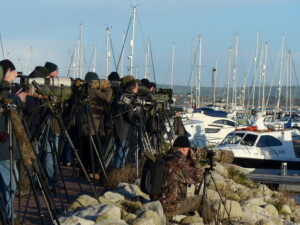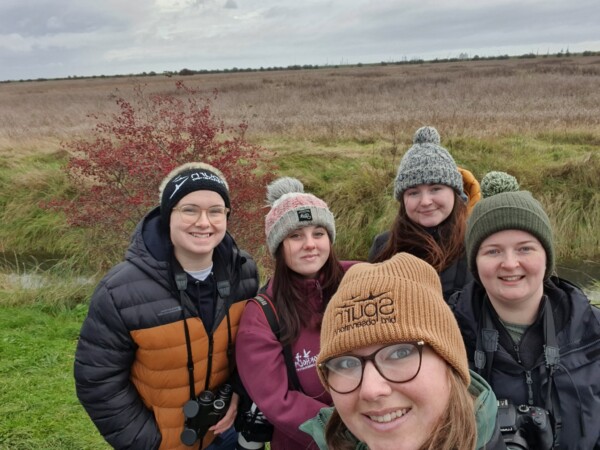 The British Ornithologists’ Union Records Committee (BOURC) adjudicates on candidate first national records of bird species (and subspecies) and has maintained an official list of British Birds for over 140 years (BOU 1883). It receives candidate records from the British Birds Rarities Committee (BBRC) which is primarily concerned with ascertaining identification, with BOURC considering questions of provenance (whether a species is a potential natural vagrant or more likely an escape from captivity). The Committee has up to ten members, recruited based on their relevant knowledge and expertise – typically gained across several decades. Committee membership includes a Chair, a Secretary, the Chair of BBRC and at least five Ordinary members. Committee membership reflects a diversity of geographic and taxonomic experience, typically including both academic and non-academic members, but it has long failed to recruit female members, the subject of this blog.
The British Ornithologists’ Union Records Committee (BOURC) adjudicates on candidate first national records of bird species (and subspecies) and has maintained an official list of British Birds for over 140 years (BOU 1883). It receives candidate records from the British Birds Rarities Committee (BBRC) which is primarily concerned with ascertaining identification, with BOURC considering questions of provenance (whether a species is a potential natural vagrant or more likely an escape from captivity). The Committee has up to ten members, recruited based on their relevant knowledge and expertise – typically gained across several decades. Committee membership includes a Chair, a Secretary, the Chair of BBRC and at least five Ordinary members. Committee membership reflects a diversity of geographic and taxonomic experience, typically including both academic and non-academic members, but it has long failed to recruit female members, the subject of this blog.
BOU and inclusion
The BOU is proud of its work tackling barriers to inclusion. One action we have taken is to set targets for equal female – male representation on BOU Council and committees. In the case of BOU Council and five of its committees, we saw a shift from a male:female ratio of 66:34 in 2018 to 47:53 in 2023, achieved in some part via opening committee nominations to a public call. In this blog we turn our attention to BOU’s Records Committee (BOURC), reflect upon the barriers to achieving equitable, diverse and inclusive membership for all ornithologists (professional and amateur) and the work we still need to do to break these down. In this blog we focus on men and women but recognise that the ways we can be more diverse and inclusive are much, much broader than this including people that do not identify as female or male.
One of the authors of this blog, Dawn Balmer, was the first female member of BOURC (and the BBRC); Dawn says “I very much enjoyed my time on BOURC and contributing to decision making for potential firsts for Britain. It was really educational and I enjoyed the research aspect, but also being able to bring my own experience from birding and ringing to the discussions was rewarding. I was invited to join BOURC by the Secretary and felt comfortable with my own bird knowledge, experience and methodological approach that I was delighted to join. BOURC meetings were initially held in-person in Peterborough and later moved to online; the meetings were always welcoming, interesting and inclusive.”
BOURC and inclusion
The pool of potential BOURC members are predominantly experts in the wider birding community, indeed, although many BOURC members have been professional ornithologists, they have invariably been obsessive birders first and scientists/NGO employees etc second, as it is this often-qualitative domain knowledge that the Committee leverages to make decisions. Of course, that same pool is currently overwhelmingly male. For example, many BOURC members have previous experience in ornithological record assessment at the subnational level as county recorders – of 90 current UK county recorders, two are female.
This birding gender bias has been subject to previous academic scrutiny and is well documented both in the UK and elsewhere in Europe and North America (e.g. Cooper & Smith 2010; Lee et al. 2015; Randler 2021). Although ornithology NGO membership and hence broad interest in birds and conservation may have gender parity, an interest in ‘serious birdwatching’ (sensu Lee et al. 2015) is currently far less widespread in women.
Many of the reasons for gender disparity are the same that drive attrition of female ornithologists – like commitments to family (Lerman et al. 2021) and consequent absence of opportunities for a time-sink recreation activity like birding. Much of the domain expertise sought by BOURC (and BBRC) comes from extensive field experience, which often starts early in life and the gendered differences in risk associated with being alone in outdoor spaces have been identified by many female birders (e.g. Bambrick 2020; McRobert 2021) as a barrier which does not affect young male birders in the same way. The preponderance of men in general is also noted as a potential barrier, and as such, the recent calls for more women-only informal birding groups (e.g. here and here and here) is likely a great initiative to create the space and camaraderie to foster female expertise.

Figure 1. Enjoying some birding at Spurn and Sunk Island © Dan Rouse.
What next?
Having an understanding of the difference between equality and equity is an important first step toward greater diversity and inclusion. Equality focuses on treating everyone the same, while equity emphasises ensuring fairness by accounting for and addressing individual differences and needs. The goal of equity is to create equal opportunities and outcomes for all, recognising and addressing disparities that may exist. Evidence tells us that groups of people (for example men and women) have different starting points in life. For example, evidence shows women experience poorer institutional support, greater care-giving demands, implicit bias, lack of role models and inadequate mentoring (Lerman et al. 2021).
In approaching female ornithologists with relevant expertise, BOURC is aware of the risk of being seen to be tokenistic and this has may have led to potential Committee members turning down the role (in addition to others who were simply uninterested or had no bandwidth to undertake it). Tokenism doesn’t lead to real change or inclusivity. Genuine diversity and inclusion efforts involve addressing structural issues, creating an environment that welcomes diversity, and ensuring that people from underrepresented groups are empowered to contribute meaningfully. Sometimes the intention can be good but in emphasising that you are asking a person or prioritising them because of a characteristic, you can diminish the skills that they have and the huge contribution they could make. Really, we should be asking what is missing by not having this richness of diversity on committees.
We only invite to BOURC those people who the Committee considers to be a qualified and deserving future member, whose contribution we would value. However, the spectre of ‘imposter syndrome’ whereby talented and capable individuals fear being seen as a fraud or non-deserving professionals (Chrousos & Mentis 2020), a fear less commonly experienced by men, may also impact diversity. Evidence shows that men will put themselves forward for a role if they don’t meet all of the criteria, whereas women would be more likely to rule themselves out. It has also been demonstrated that how we describe a role, and the words we use, can affect whether women will apply.
So, what can we do about this? With the BOURC membership criteria in mind (see below) we can take steps to create the conditions for all people with the complementary mix of skills to come forward. However, we can also take proactive steps to support those who feel unsure about whether they could do the role, and help those who currently don’t meet the criteria but who have huge potential, for example, through mentorship.
We want to emphasise that candidates need not have a stellar birding CV of vagrant ‘finds’ from extended periods at coastal watchpoints to apply – recruiting people with a quantitative understanding of bird migration ecology and/or the wild bird trade, for example, is arguably more important for BOURC’s remit. Criteria against which potential new members are assessed include knowledge of: rarity record assessment, regional biological recording, bird identification, taxonomy, vagrancy patterns, captive bird trade and museum skins/collections but it is not expected that members will have experience covering all these bases.
BOURC meets twice annually on Zoom. You don’t need to be an existing member of the BOU to be nominated/to nominate yourself, but we do require you to become a member. We recognise this imposes another barrier and if cost is prohibitive, we encourage you to speak with us about this in confidence.
Get nominating!
We are committed to doing the work to break down barriers and are listening to feedback from the ornithology community. What can you do? Please think about your great ornithology peers and ask yourself why they might not be putting themselves forward for these opportunities. If you think they would be a great addition to the Committee please do nominate them.
If you would like to make a contribution to the Committee, we support and encourage you to put yourself forward for membership in the current open call. If you are not sure, as a first step, please get in touch with Dawn, who is happy to share her experience, Leila, Alex or an existing member of the Committee to discuss the role.
Acknowledgements
Thank you to Ailidh Barnes, Sian Knott and Tom Finch for comments.
Image Credits
Top right: Collection of Birders © Dawn Balmer.
References
Bambrick, M. 2020. Where are the young women in birding? VIEW
British Ornithologists’ Union (BOU). 1883. A List of British Birds Compiled by a Committee of the British Ornithologists Union. John van Voorst: London.
Chrousos, G.P., Mentis, A.F.A. 2020. Imposter Syndrome Threatens Diversity. Science 367. VIEW
Cooper, C.B., Smith, J.A. 2010. Gender patterns in bird-related recreation in the USA and UK. Ecology and Society 15:4. VIEW
Lee, S., McMahan, K., Scott, D. 2015. The gendered nature of serious birdwatching. Human Dimensions of Wildlife 20. VIEW
Lerman, S.B. Pejchar, L., Benedict, L., Covino, K.M., Dickinson, J.L., Fantle-Lepczyk, J.E., Rodewald, A.D., Vleck, C. 2021. Juggling parenthood and ornithology: A full lifecycle approach to supporting mothers through the American Ornithological Society. The Condor 123. VIEW
McRobert, L. 2021. Call it out. VIEW
Randler, C. 2021. An analysis of heterogeneity in German speaking birdwatchers reveals three distinct clusters and gender difference. Birds 2. VIEW
If you want to write about your research in #theBOUblog, then please see here.




